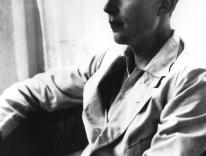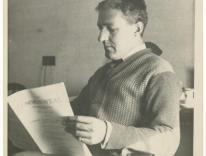Okay, with New Hampshire behind us in the primary season, and South Carolina set to unfold, lets get down to what’s really at stake in this year’s election. Defying all pundits, the primaries are setting up what could be a potentially historic confrontation between two outsider candidates representing diametrically opposed poles of American life. I’m not talking about what visions float in the heads of Donald Trump and Bernie Sanders. I’m talking about what’s on their heads -- or what isn’t.
Much has been said about Bernie as a pathbreaking occupant of the White House: first socialist president, first Brooklyn-born president, first Jewish president, oldest president. But another category gets less attention: the bald president. No, Bernie wouldn’t be the first. But he’d be one of the very, very few.
Statistics and history demonstrate our collective reluctance to install a glistening dome in the Oval Office. While serious pattern baldness afflicts roughly 60% of American men in their 60s, its incidence among Presidents is far lower – just 11%. That’s five men, in other words, and all but one of them pre-modern: John Adams, John Quincy Adams, Martin Van Buren, James Garfield, and Dwight Eisenhower. (There’s also Gerald Ford, who was not elected, and who lost to the notably hirsute Jimmy Carter.) The last time we chose a bald president was sixty years ago – and he had to be a conquering global war hero to overcome the hair hurdle.
Why is this? We all know that physical attributes shape prevailing conceptions of a “presidential” bearing -- we rarely elect short presidents, for instance. Of course, height’s relationship to power is easy to grasp, denoting domination, vision, a stature closer to the gods; in this country the career-earnings advantage that accrues to every inch over average height (for a man, anyway) has been extensively studied.
But what about hair, or the lack of it?
Let me pause to dilate on the aesthetics and hermeneutics of baldness (full disclosure: I write as a lion-maned – um, I mean, conventionally-haired -- male, and thus likely prone to the errors and presumptions of hirsutonormativity). Baldness has always had its mockable aspect, well documented in literature and popular culture. Presumably the condescending affection we feel for Vladimir Nabokov’s comic protagonist, Timofey Pnin (“Ideally bald, he began rather impressively with that great brown dome of his... but ended, somewhat disappointingly, in a pair of spindly legs... and frail-looking, almost feminine feet”) is not what campaign managers want to elicit in voters. Nor do Mr. Magoo or Elmer Fudd exactly model the presidential; indeed their endearing haplessness reflects the common use of baldness as a trope for emasculation and befuddlement, the half-blind, deluded oldster, the pathetic loser, adorable but helpless, let’s pat his cute bald head. President Fudd!
And yet, confusingly, a bald-is-cool counter-esthetic has been vigorously in play for decades now, going back in my lifetime to Telly Savalas’ Kojak, later immensely amplified by Michael Jordan, and continuing all the way to the Silicon Valley Bald of today’s startup generation. The list of Cool Bald Guys includes: Andre Agassi, Samuel L. Jackson, Kobe Bryant, Patrick Stewart, Moby, LL Cool J, Cal Ripken, Kevin Garnett, Albert Pujols, Sean Connery, Yul Brynner, Steven Soderbergh, Matt Lauer.
Nor is the allure limited to actors and athletes. Baldness ranges freely in the upper ranks of power. Consider such glossy-pated icons of power as Lloyd Blankfein, Jeffrey Katzenberg, Dick Cheney, Ben Bernanke, Steve Ballmer, John McCain, Jeff Bezos, Rupert Murdoch... and don’t forget Pope Francis or the Dalai Lama. Or Gandhi. Or Gorbachev. GQ even puts out a list, The Hundred Most Powerful Bald Men in the World. And the website Business Insider cites research from the University of Pennsylvania to support the notion that “there's something powerful about having a smooth dome,” insisting that “people are psychologically biased to see bald men as dominant leaders.”
Really? If so, we don’t show it come presidential election time. One British hair-loss treatment center makes a curious sales pitch titled “History Shows Americans Don’t Want a Bald President.” Pointing out a “Similar Reaction to Bald Leaders in the UK,” the website notes that the last bald PM was Churchill, speculates that Tony Blair won in 1997 because of his “fuller, more youthful hair,” accuses current PM David Cameron of a surreptitious comb-over, “slicking his hair back following press stories about his bald spot” -- and recommends, “given this link between power and hair,” that the politically ambitious get “hair loss treatment to help win votes.”
Will that be the final take-home of this year’s campaign? Or will baldness finally prevail, as Bernie storms the White House with his glistening, tufted pate? After all these decades, will we finally Feel the Bald?
And could there be a more perfect antagonist in this great national argument than The Donald? Traditionally in choosing presidents we haven’t exactly favored the flamboyant, but the closest we’ve come – JFK and Reagan – both had, for US Presidents anyway, Big Hair. Trump, of course, takes Big Hair, like everything else, to another level. His bouffant, literally over-the-top ‘do is not just a wave but a tsunami of hair, a gladiator’s helmet, a monarch’s diadem: choose your metaphor! This is hair so opulent that it piles up like a Midas’ treasure, yuuuuuge hair, a gleaming objective-correlative to its owner’s most famous creation -- The Donald, crowning himself with his own crowning achievement, a veritable Trump Tower of hair.
So what do Americans want, the Glistening Dome or the Golden Cockscomb? At long last, things are setting up for a clarifying election, not only across the ideological divide, but the cranial one.


